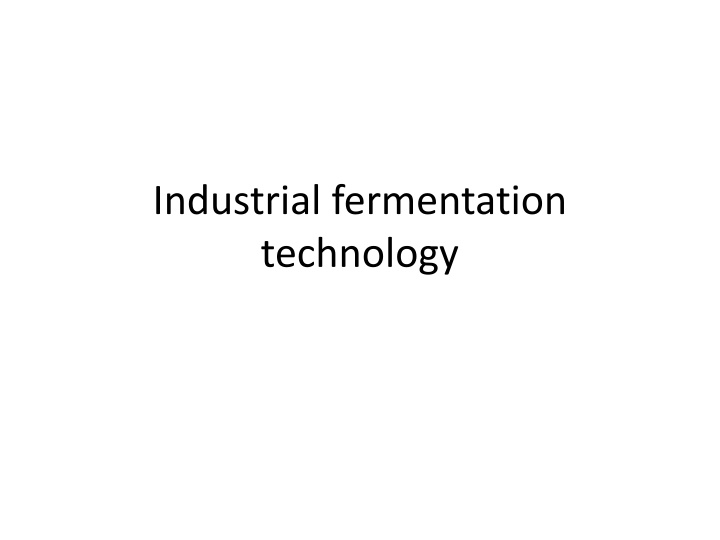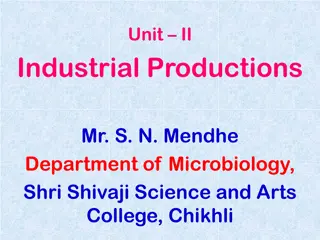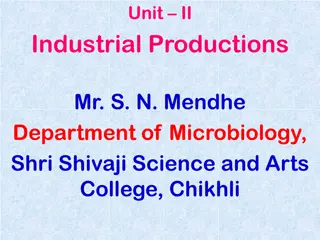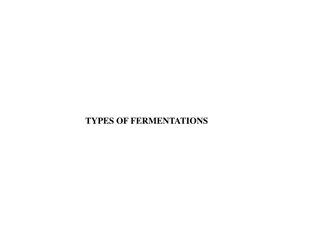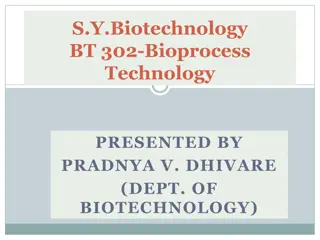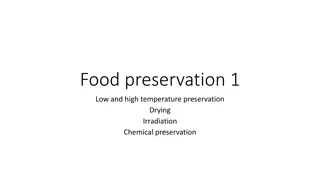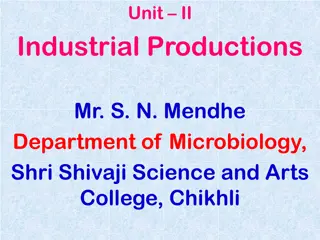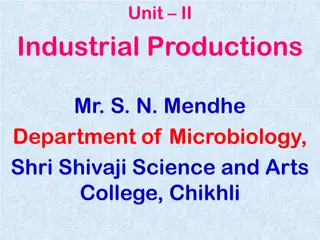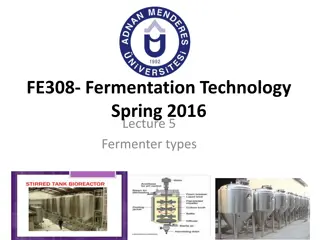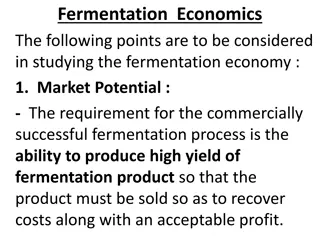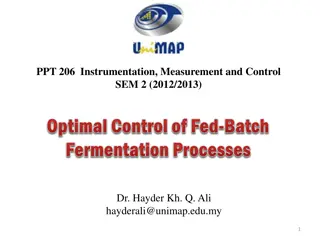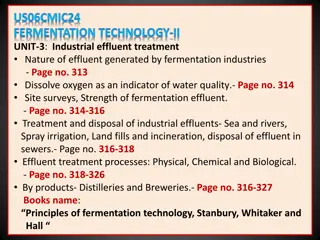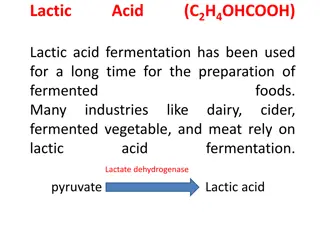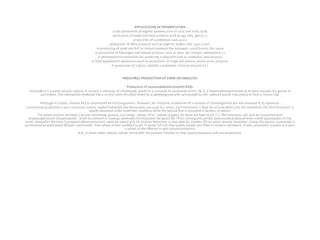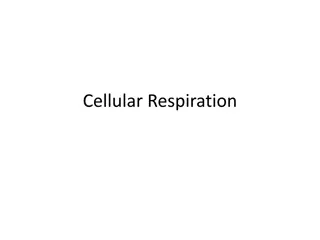Industrial fermentation technology
Industrial fermentation technology involves three key stages - Up-Stream Processing (USP), the fermentation process, and Down-Stream Processing (DSP). USP includes formulating the fermentation medium, sterilization, inoculum preparation, and improving desired microorganisms for increased productivity. The fermentation medium should contain essential nutrients, while waste products from other processes can be utilized. Inoculum preparation involves seed culture development, and sterilization is crucial for preventing contamination with undesired microorganisms.
Download Presentation

Please find below an Image/Link to download the presentation.
The content on the website is provided AS IS for your information and personal use only. It may not be sold, licensed, or shared on other websites without obtaining consent from the author.If you encounter any issues during the download, it is possible that the publisher has removed the file from their server.
You are allowed to download the files provided on this website for personal or commercial use, subject to the condition that they are used lawfully. All files are the property of their respective owners.
The content on the website is provided AS IS for your information and personal use only. It may not be sold, licensed, or shared on other websites without obtaining consent from the author.
E N D
Presentation Transcript
Industrial fermentation technology
Industrial fermentation processes require three most important stages to complete product fermentation. These are: up-stream processing (abbreviated as USP) the fermentation process down-stream processing (DSP).
Stage # 1. Up-Stream Process USP includes formulation of the fermentation medium, sterilization of air, fermentation medium and the fermenter, inoculum preparation and inoculation of the medium. This process comprises of obtaining a desired microorganism, and its improvement so as to enhance the productivity and yield. It also includes the maintenance of strain purity, preparation of inocula and further efforts to improve the economic efficiency of the process. There are two distinct processes involved in USP but both the processes run simultaneously. The medium is prepared for the culture (inoculum) preparation as well as for the production of desired product.
Steps of up-stream processes: formulation of the fermentation medium The fermentation medium should contain an energy source, a carbon source, a nitrogen source and micronutrients required for the growth of the microorganism along with water and oxygen, if necessary. A medium which is used for a large scale fermentation, in order to ensure the sustainability of the operation, should have the following characteristics; 1. It should be cheap and easily available 2. It should maximise the growth of the microorganism, productivity and the rate of formation of the desired product 3. It should minimise the formation of undesired products Usually, waste products from other industrial processes, such as molasses, lignocellulosic wastes, cheese whey and corn steep liquor, after modifying with the incorporation of additional nutrients, are used as the substrate for many industrial fermentations.
Steps of up-stream processes: inoculum preparation Inoculum build up is the preparation of the seed culture in amounts sufficient to be used in the large fermenter vessel. This involves growing the microorganisms obtained from the pure stock culture in several consecutive fermenters. This process cuts down the time required for the growth of microorganisms in the fermenter, thereby increasing the rate of productivity. Then the seed culture obtained through this process is used to inoculate the fermentation medium. USP
Steps of up-stream processes: sterilization Sterilization is essential for preventing the contamination with any undesired microorganisms. Air is sterilized by membrane filtration while the medium is usually heat sterilized. Any nutrient component which is heat labile is filter- sterilized and later added to the sterilized medium. The fermenter may be sterilized together with the medium or separately.
Stage # 2. Fermentation Process The fermentation process involves the propagation of the microorganism and production of the desired product. The fermentation process can be categorized depending on various parameters. It can be either aerobic fermentation, carried out in the presence of oxygen or anaerobic fermentation, carried out in the absence of oxygen. Many industrial fermentation are carried out under aerobic conditions where a few processes such as ethanol production by yeast require strictly anaerobic environments.
Modes of operation The fermentation process can also be divided into three basic systems, namely batch, continuous or fed-batch, depending on the feeding strategy of the culture and the medium into the fermenter. In a batch operation, the medium and the culture are initially fed into the vessel and it is then closed. After that, no components are added apart from oxygen (in an aerobic process) and acid or alkali for the pH adjustment. The fermentation is allowed to run for a predetermined period of time and the product is harvested at the end. In a continuous process, fresh medium is continuously added and the products, along with the culture is removed at the same rate, thus maintaining constant concentrations of nutrients and cells are maintained throughout the process. A fed-batch system is a combination of these two systems where additional nutrients are added to the fermenter as the fermentation is in progress. This extends the time of operation but the products are harvested at the end of the production cycle as in a batch fermenter.
The process can also be categorised as solid state fermentation (SSF) or submerged fermentation (SmF), depending on the amount of free water in the medium. In a solid state fermentation, the medium contains no free flowing water. The organisms are grown in a solid substrate which is moistened. This is used in certain industrial process such as koji fermentation from soybeans, production of amylase and protease by Aspergillus oryzae on roasted soybeans and wheat, bioremediation, detoxification of agro-industrial wastes, etc. Submerged fermentation is in which microorganisms grow submerged in a liquid medium where free water is abundant. This is the method of choice for many industrial operations over SSF although SSF is also rapidly gaining interest in the present.
A classification, based on the product formation in relation to energy metabolism Type I Fermentation: When the product is formed directly from the primary metabolism used for energy production, it is referred to as type I and may be represented as. Growth, energy metabolism and product formation almost run in a parallel manner (production of ethanol, gluconic acid and single-cell protein). Type II fermentation: In type II category, the product is also formed from the substrate used for primary energy metabolism. At the beginning, the growth of the microorganisms is accompanied by high substrate utilization with little or no product formation. Now the growth is slowed down but the substrate consumption is high, and this is coupled with product formation (production of some amino acids, citric acid and itaconic acid). Type III fermentation: There is a clear distinction between the primary metabolism and product formation in type III fermentation (Fig. 19.15C) as they occur at separate times. Substrate consumption and rapid growth occur in the first phase and the product formation occurs in the second phase. The product is formed from amphibolic metabolic pathways and not from primary metabolism e.g. production of vitamins and antibiotics.
Types of fermenters: Continuous Stirred-Tank Fermentor The continuous stirred-tank reactor (CSTR) is composed of a vessel with pipes, pumps, valves, agitator, motor, shaft, and impeller(s). The shaft is situated at the bottom of the tank, and the number of impellers depends on the size of the bioreactor. In this type of fermentor, a structure called sparger is found that keeps adding air to the culture medium. It is a ring-like structure with many holes. The sparger, along with the impellers, distribute gas in the entire vessel. The impellers break down the bubbles into smaller ones that are homogeneously distributed in the bioreactor.
Types of fermenters: Airlift Fermentor The airlift bioreactors contain a baffle or a draft tube in the middle through which air is pumped into the vessel. There are two types of airlift fermentors: Internal loop airlift bioreactor: It has a single central draft tube that provides inner circulation channels. External loop airlift bioreactor: It contains external loops that separate the liquids flowing into independent channels.
Types of fermenters: Packed Bed Fermentor In a packed bed fermentor, a hollow tube or pipe is packed with a biocatalyst. The bed is immobile in nature. The culture medium flows through the biocatalyst, which produces the metabolites continuously in the broth. These bioreactors are easy to operate but are often blocked due to poor oxygen circulation. Fluidised Bed Fermentor In this type of reactor, a solid granular bed that is usually made up of a biocatalyst is present. The fluid, that is, liquid or gas, is passed through the solid bed at high speeds, such that the suspended solid behaves like a fluid. This type of fermentor is used for microbial flocs, immobilised cells, and enzymes.
Membrane Fermentor Membrane bioreactors work in conjugation with ultrafiltration and microfiltration. This type of fermentor is used for the biological treatment of wastewater. There are two types of membrane bioreactors: Submerged membrane bioreactor: In this type of fermentor, the membrane is found inside the vessel submerged in the wastewater. Side-stream membrane bioreactor: In this type of fermentor, the membrane is found outside the reactor and filtration by the membrane is an additional step in the whole process.
Bubble Column Fermentor A bubble column fermentor is equipped with a cylindrical column that is filled with liquid, and gas is inserted into it from the bottom. It is vertically arranged, such that the introduction of gas from the bottom creates a turbulent stream and allows optimum gas exchange. The sparger mixes the contents of the vessel. The liquid flows either in a parallel direction or in a counter-current direction.
Stage # 3. Down-Stream Process: Downstream Processing includes the recovery of the products in a pure state and the effluent treatment. Product recovery is carried out through a series of operations including cell separation by settling, centrifugation or filtration; product recovery by disruption of cells (if the product is produced intracellularly); extraction and purification of the product. Finally, the effluents are treated by chemical, physical or biological methods. Commercially important products of fermentation can be described in five major groups as follows: 1. Biomass (Baker s yeast, SCP, Starter cultures, animal feed, etc.) 2. Primary metabolites (amino acids, organic acids, vitamins, polysaccharides, ethanol, etc.) and secondary metabolites (antibiotics, etc.) 3. Bioconvertion or biotransformation products (steroid biotransformation, L-sorbitol etc.) 4. Enzymes (amylase, lipase, cellulase, etc.) 5. Recombinant products (some vaccines, hormones such as isulin and growth hormones etc.)
The DSP consists of series of distinct unity or processes which are connected to each other for getting the final product as shown in Fig 20.5.
Cell Harvesting: Since, microbial cells are in liquid medium or broth, solid-liquid separation method is influenced by the size and morphology of the microorganisms (single cells, aggregates or mycelia). Further, the process also depends upon the location of product whether it is intracellular or extracellular it has been secreted into the medium. Besides, other factors such as specific gravity, viscosity, and rheology of the medium also influence cell harvesting method.
Broth Conditioning Technique: This technique allows separation of cells from large volume of liquid medium. In this case, cells are allowed to form floccules or precipitate by using chemical, physical and biological treatments. Coagulating materials such as simple electrolytes, acids, bases, salts, multivalent ions etc. are added to form small floes from dispersed colloids or suspended materials. Certain floes precipitation methods are also used at the end of many traditional beer and wine fermentation processes for the precipitation of yeast cells.
Sedimentation: This process is widely used for yeast separation during alcohol production and in waste-water treatment. The rate of particle sedimentation is a function of both size and density. If, larger the size, greater its density, and the faster rate of sedimentation. Therefore, for quick separation, the difference in density between the particle and the medium must be large with low viscosity. Centrifugation: This process allows small particles or cells to separate from liquid. It is also suitable for some liquid-liquid separations. Similar to sedimentation, its effectiveness also depends upon cell size, density difference between the cells and the medium, and its viscosity. Higher speed of centrifugation requires for the separation of smaller microorganisms, such as bacteria. In case of yeast cells present in beer, relatively, low centrifugation effectively recovers residual yeast cells.
Filtration: There are certain filters such as clothes, glass wool or cellulose that retain the solids and pass on the liquid. The solids accumulate above the filter. Such technique is useful in case of fungal mycelia separation. There are two types of filters used in industrial process: plate and frame filters or filter press, and rotatory vacuum filter, which help in harvesting the fungal mycelia during antibiotic manufacture, bakers yeast production and in dewatering of sewage sludge.
Disruption of Microbial Cells: When the product is intracellular, it is necessary to disrupt the cells/cell membrane so as to release the product. Cell disruption can be achieved by mechanical and non-mechanical methods. Some of the methods used are ultra-sonication and application of lysozyme. The French-press is often used in laboratories, while Manton and Gaulin homogenizer (high pressure homogenizer) is employed for pilot scale cell disruption. These are used for disruption of bacterial, yeast cells and fungal mycelia. The non-mechanical cell disruption is carried out by cell permeabilization. This can be accompanied by autolysis, osmotic shock, ruptures by ice crystal or heat shock treatment. Some organic solvents such as acetone, butanol, chloroform and methanol have been used to release enzymes from microorganisms. Simple treatment with sodium dodecyl sulfate (SDS) or Triton X-100 is also found effective. Lysozyme is useful for Gram-positive organisms but addition of EDTA improves the effectiveness of lysozyme of Gram-negative bacteria. Some antibiotics namely penicillin and cycloserine may also be used to lyse the actively growing bacterial cells. Chitosan is effective for yeast cells.
